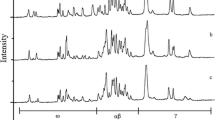Abstract
An approach was established using RP-HPLC (reversed-phase high-performance liquid chromatography) to identify ten species of Rhodiola, R. coccinea A. Bor, R. junggarica C.Y. Yang et N.R. Cui spn., R. heterodonta A. Bor, R. linearifolia A. Bor, R. pamiro alaiucm A. Bor, R. kaschgarica A. Bor,R. litwinowii A. Bor, R. gelida, schrenk, R. rosea L. and R. quadrifide Fisch et Mey collected from the Tianshan Mountains areas of China. Chromatograms of alcohol-soluble proteins, generated from these ten Rhodiola spp. were compared. Each chromatogram of alcohol-soluble proteins came from a single seed of one wild species only. The results showed that when using a Waters Delta Pak. C18, 5 μm particle size reversed phase column (150 mm×3.9 mm), a linear gradient of 22%–55% solvent B with a flow rate of 1 ml/min and a run time of 67 min, the chromatography gave optimum separation of Rhodiola alcohol-soluble proteins. Chromatogram of each species was different and could be used to identify those species. Cluster analysis of genetic similarity coefficients of 37% to 60% showed a medium degree of genetic diversity among the species in these eco-areas. Cluster analysis showed that the ten species of Rhodiola can be divided into four clusters and yielded the general and unique biochemical markers of these species. RP-HPLC was shown to be a rapid, repeatable and reliable method for Rhodiola species identification and analysis of genetic diversity.
Similar content being viewed by others
References
Batey, I.L., 1984. Wheat varietal identification by rapid ion-exchange chromatography of gliadins.Journal of Cereal Science,2:241–248.
Bietz, J.A., 1983. Separation of cereal proteins by reversed-phase high-performance liquid chromatography.Journal of Chromatography 155:219–238.
Bietz, J.A., Cobb, L.A., 1985. Improved procedures for rapid wheat varietal identification by reversed-phase high-performance liquid chromatography of gliadin.Cereal Chemistry,62:332–339.
Brink, D.E., Price, S.C., Nguyen, H., Martinez, C., 1989. Genetic purity assessment of commercial single cross maize hybrids: Isoelectric focusing of zein.Seed Science and Technology,17:91–98.
Dinelli, G., Bonetti, A., 1992. Capillary electrophoresis in species and cultivar determination.Seed Science and Technology,20:241–249.
Huebner, F.R., Bietz, J.A., Webb, B.D., Juliano, B.O., 1990. Rice cultivar identification by high-performance liquid chromatography of endosperm proteins.Cereal Chemistry,67:129–135.
Kubiezek, R.P., Huebner, F.R., Bietz, J.A., 1993. Reversed-phase high-performance liquid chromatography of secalins: Application to rye cultivar identification.Journal of Cereal Science,17:191–201.
Lookhart, G.L., Pomeranz, Y., 1984. Characterization of oat species by polyacrylamide gel electrophoresis and high performance liquid chromatography of their prolamin proteins.Cereal Chemistry,62:162–166.
Luo, C.H., Shu, R., Gao, Y., 1996. Experiment study of anti-fatigue and anti-radiation effect of high-mountain plantRhodiola L.Modern Apply Med,13(4):5–7 (in Chinese with English abstract).
Marchylo, B.A., Kruger, J.E., 1984. Identification of canadian barley cultivars by reversed-phase high-performance liquid chromatography.Cereal Chemistry,61:295–301.
Ram, C., Huebner, F.R., Bietz, J.A., 1995. Identification of Indian wheat varieties by reversed-phase high-performance liquid chromatography.Seed Science and Technology,23:259–262.
Smith, J.S.C., Smith, O.S., 1992. Fingerprinting crop varieties.Advances in Agronomy,47:85–140.
Sun, F., Wang, X.Q., Li, J.B., 1993. Experiemntal study the anti-AsQ B5 virus's effect of Rhodiola.Chin Tradit Herb Drugs,24(10):532–534 (in Chinese with English abstract).
Wang, X.Q., Li, J.B., Zhang, H.Y., 1992. Experimental study the anti-tumor effect ofRhodiola L.JILIN Tradit Chin Med,3:40–42 (in Chinese with English abstract).
Xu, B.J., Zhen, Y.N., Li, X.G., 2000. New development ofRhodiola L. plant research.Chinese Medicine,23(9): 580–584 (in Chinese).
Yi, G.S., Zhou, J.Q., Wang, G.X., 1992. Study the prolong life effect of extraction ofRhodiola L. root.Acta Nutrit Sini,14(1):98–100 (in Chinese with English abstract).
Zu, Y.G., Yan, T.F., Zhou, F.J., 1998. A preliminart study on genetic variation and endangered mechanism ofRhodiola Sachalinensis natural population.Bulletin of Botanical Research,18(3):304–310 (in Chinese with English abstract).
Author information
Authors and Affiliations
Corresponding author
Additional information
Project (No. 30470330) supported by the National Natural Science Foundation of China
Rights and permissions
About this article
Cite this article
Wang, Q., Ruan, X., Jin, Zh. et al. Identification of Rhodiola species by using RP-HPLC. J Zheijang Univ Sci B 6, 477–482 (2005). https://doi.org/10.1631/jzus.2005.B0477
Received:
Accepted:
Published:
Issue Date:
DOI: https://doi.org/10.1631/jzus.2005.B0477




